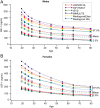Applying precision medicine to the diagnosis and management of endocrine disorders
- PMID: 35968864
- PMCID: PMC9513637
- DOI: 10.1530/EC-22-0177
Applying precision medicine to the diagnosis and management of endocrine disorders
Abstract
Precision medicine employs digital tools and knowledge of a patient's genetic makeup, environment and lifestyle to improve diagnostic accuracy and to develop individualised treatment and prevention strategies. Precision medicine has improved management in a number of disease areas, most notably in oncology, and it has the potential to positively impact others, including endocrine disorders. The accuracy of diagnosis in young patients with growth disorders can be improved by using biomarkers. Insulin-like growth factor I (IGF-I) is the most widely accepted biomarker of growth hormone secretion, but its predictive value for recombinant human growth hormone treatment response is modest and various factors can affect the accuracy of IGF-I measurements. These factors need to be taken into account when considering IGF-I as a component of precision medicine in the management of growth hormone deficiency. The use of genetic analyses can assist with diagnosis by confirming the aetiology, facilitate treatment decisions, guide counselling and allow prompt intervention in children with pubertal disorders, such as central precocious puberty and testotoxicosis. Precision medicine has also proven useful during the transition of young people with endocrine disorders from paediatric to adult services when patients are at heightened risk of dropping out from medical care. An understanding of the likelihood of ongoing GH deficiency, using tools such as MRI, detailed patient history and IGF-I levels, can assist in determining the need for continued recombinant human growth hormone treatment during the process of transitional care.
Keywords: adolescent; biomarkers; child; early diagnosis; endocrine diagnosis; genetic testing; growth hormone; precision medicine; precocious puberty; transitional care.
Figures


Similar articles
-
Growth hormone deficiency impedes the rise in plasma insulin-like growth factor I levels associated with precocious puberty.J Pediatr. 1989 Jul;115(1):64-8. doi: 10.1016/s0022-3476(89)80330-0. J Pediatr. 1989. PMID: 2738797
-
AMERICAN ASSOCIATION OF CLINICAL ENDOCRINOLOGISTS AND AMERICAN COLLEGE OF ENDOCRINOLOGY GUIDELINES FOR MANAGEMENT OF GROWTH HORMONE DEFICIENCY IN ADULTS AND PATIENTS TRANSITIONING FROM PEDIATRIC TO ADULT CARE.Endocr Pract. 2019 Nov;25(11):1191-1232. doi: 10.4158/GL-2019-0405. Endocr Pract. 2019. PMID: 31760824
-
Evaluation of insulin-like growth factor-1 and insulinlike growth factor binding protein-3 in diagnosis of growth hormone deficiency in short-stature children.J Ayub Med Coll Abbottabad. 2009 Jul-Sep;21(3):40-5. J Ayub Med Coll Abbottabad. 2009. PMID: 20929010
-
Somatotropic-Testicular Axis: A crosstalk between GH/IGF-I and gonadal hormones during development, transition, and adult age.Andrology. 2021 Jan;9(1):168-184. doi: 10.1111/andr.12918. Epub 2020 Oct 23. Andrology. 2021. PMID: 33021069 Review.
-
Digital Health for Supporting Precision Medicine in Pediatric Endocrine Disorders: Opportunities for Improved Patient Care.Front Pediatr. 2021 Jul 29;9:715705. doi: 10.3389/fped.2021.715705. eCollection 2021. Front Pediatr. 2021. PMID: 34395347 Free PMC article. Review.
Cited by
-
Key Stages in the Development and Establishment of Paediatric Endocrinology: A Template for Future Progress.Horm Res Paediatr. 2024;97(1):22-27. doi: 10.1159/000530841. Epub 2023 Apr 25. Horm Res Paediatr. 2024. PMID: 37166328 Free PMC article. Review.
-
[Management of transition growth hormone deficiency].Zhongguo Dang Dai Er Ke Za Zhi. 2024 Mar 15;26(3):224-229. doi: 10.7499/j.issn.1008-8830.2309173. Zhongguo Dang Dai Er Ke Za Zhi. 2024. PMID: 38557372 Free PMC article. Chinese.
-
A Comprehensive Review of the Role of Biomarkers in the Early Detection of Endocrine Disorders in Critical Illnesses.Cureus. 2024 May 31;16(5):e61409. doi: 10.7759/cureus.61409. eCollection 2024 May. Cureus. 2024. PMID: 38947617 Free PMC article. Review.
-
Retrospective Analysis of Effective Management Strategies for Primary Amenorrhea of Reproductive Age in Saudi Arabia.Life (Basel). 2024 Jun 17;14(6):772. doi: 10.3390/life14060772. Life (Basel). 2024. PMID: 38929754 Free PMC article.
References
-
- Fernandez-Luque L, Al Herbish A, Al Shammari R, Argente J, Bin-Abbas B, Deeb A, Dixon D, Zary N, Koledova E, Savage MO. Digital health for supporting precision medicine in pediatric endocrine disorders: opportunities for improved patient care. Frontiers in Pediatrics 20219 715705. (10.3389/fped.2021.715705) - DOI - PMC - PubMed
-
- Tenenbaum JD, Avillach P, Benham-Hutchins M, Breitenstein MK, Crowgey EL, Hoffman MA, Jiang X, Madhavan S, Mattison JE, Nagarajan Ret al.An informatics research agenda to support precision medicine: seven key areas. Journal of the American Medical Informatics Association 201623791–795. (10.1093/jamia/ocv213) - DOI - PMC - PubMed
Publication types
LinkOut - more resources
Full Text Sources

